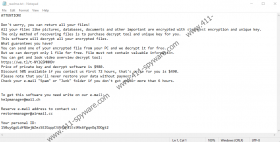Agho Ransomware Removal Guide
Agho Ransomware is one of the thousands of infections that have been created to corrupt documents, videos, presentations, projects, notes, photos, and other personal files. These infections corrupt these kinds of files because they intend to hit victims where it hurts most. If system files were corrupted, they could be replaced, and the system could be reinstalled. However, when personal files are encrypted, victims might panic and fall into despair. That is a recipe for disaster because cybercriminals know that it is easier to scam people who are more vulnerable. Hopefully, you do not need to delete Agho Ransomware yet, and you have time to secure your personal files and also your Windows operating system. We discuss how to do that, as well as how to remove the infection if it manages to slither in. Keep reading if you are interested, and use the comments section below if you want to continue the discussion.
If you are trying to protect your system against Agho Ransomware, its clones from the STOP Ransomware family (e.g., Sglh Ransomware and Lisp Ransomware), or any other infection alike, you need to be most vigilant about spam emails, downloaders, and unpatched vulnerabilities. This is what creates the security backdoors for cybercriminals, and they can drop malware or even make you execute it quite easily. If the system has a reliable security system, malware should be detected and removed immediately. However, if the system is not secured, the ransomware can slither in silently, without ringing any alarm bells. After the initial attack, Agho Ransomware moves on to encrypt files, and it does that using a unique encryption key. This ensures that victims cannot use public decryptors to free their files. That said, a decryptor was built for STOP Ransomware. Hopefully, you can restore your files using this tool, but be careful when installing it. Note that you could face counterfeit tools that, in fact, conceal other infections.
Since the free decryptor does not appear to offer full decryption, the victims of Agho Ransomware are likely to be stuck in a terrible spot. After encryption, the corrupted files are basically locked. You can determine which ones were corrupted by looking at their names because the “.agho” extension should be attached. The files are “locked,” because the data has been changed, and normal programs cannot decipher it to make the files readable again. That is what the decryptor is for, and Agho Ransomware was created so that cybercriminals could sell their own decryptor. Can you trust them to provide you with this tool? Of course, you cannot, and that is why you should not believe the promises made via the file named “_readme.txt.” It is the ransom note that belongs to the infection, and it is meant to convince you to email the attackers (helpmanager@mail.ch or restoremanager@airmail.cc) and then pay a ransom ($490). This is a perfectly throughout scam because the attackers know that victims generally have no other option, and there is also no one that can return anonymous transactions or make the attackers send a decryptor.
Basically, Agho Ransomware was created to scam money out of you, and if you do not want to lose money along with your files, you want to stay away from the ransom note. Even emailing the attackers could be extremely dangerous. Remember that the ransomware itself is often spread via spam emails, and so you do not want to disclose your email address to make the distribution of new malware launchers even easier on the attackers. If you find yourself in a situation where you need to remove Agho Ransomware, it is absolutely the best thing for you to install anti-malware software. This software can automatically delete the threat, and it also can secure your system for the future. Although it cannot restore your files, perhaps you can do that using a free decryptor, or you can use backup copies to replace the files. The existence of ransomware is one of the biggest reasons why backing up files and creating copies of them is extremely important. Do not forget about that in the future.
How to delete Agho Ransomware
- Delete recently downloaded suspicious files.
- Launch File Explorer (by tapping Win+E keys) and ether %LOCALAPPDATA% into the quick access field.
- Delete the folder that contains the malicious {unique name}.exe file of the infection.
- Enter %HOMEDRIVE% into the quick access field.
- Delete the ransom note file named _readme.txt and also the folder named SystemID.
- Once you Empty Recycle Bin, perform a full system scan using a trusted malware scanner.
Agho Ransomware Screenshots:


